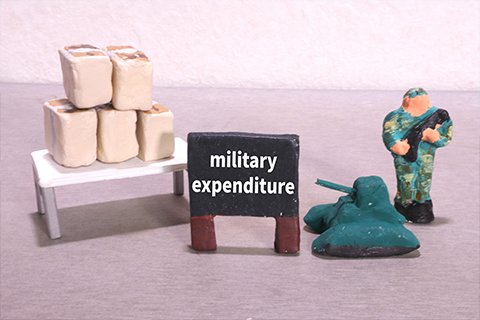Japan's Defense Budget Hike - a Fig Leaf on Japan's Structural Vulnerabilities
2023.12.12
From December 2022, the Kishida administration announced that it would incrementally raise the defense budget over the next five years. Several governmental documents explained that this would represent an estimated 60% increase of the defense budget. By 2027, the defense budget is set to reach ¥8.9 trillion (or about $66 billion) and hover at 1.5% of the GDP. The oft quoted "2% of the GDP" target relayed in the media refers to an aggregate of security-related expenditures - which include but are not limited to the defense budget. Hike in the defense budget alone will shatter the historical ceiling of the 1% limit - a legacy of postwar Japan - in ways that none of Kishida's predecessors ever dared to do. Although this 1% limit has never been legally binding, Kishida's proposition is in a way a continuation of former Prime Minister Abe's agenda, and clearly signals his desire to bring Japan back into the fold of the "normal powers," and that from now on, the extent of its defense budget will be dictated by the seriousness of the threats it perceives rather than by unwritten rules.
There is no doubt that tax payers will want to know how the government intends to finance these new expenditures, and what they actually consist of. Fiscal resources will be drawn from a tax increase on income, corporate revenues, and tobacco. But although public support for defense spending has hit an all-time high in postwar Japan, a large majority of the Japanese population remains opposed to raising taxation levels for this purpose. To the government, this is all the more difficult because other spending priorities such as pensions compete with defense for larger shares of the government's budget. The same logic will also undermine the government's promise to partly fund the new defense budget with cuts in other public expenditures.
How will Japan use this budget? The Japanese government has said that some of it will be used to replenish ammunition stockpiles, identified by the JSDF as a lingering problem. The new budget will also serve to finance new types of procurements and expand the JSDF's capabilities in new directions. Japan intends to obtain "counter opposing forces from a safe distance without being attacked." This necessarily puts a heavy focus on missiles. These would include the procurement of Tomahawks cruise missiles, the air-launched standoff land-attack Joint Strike Missiles for its F-35 fighter jets, a program to extend the range of its domestic Type 12 ground-launched anti-ship missile (produced by Mitsubishi), and the development of hypersonic weapons. Japan will also increase the number of airborne and seaborne platforms. It will purchase more F-35s, and the Japanese government also plans to put ¥64 billion on the table to build a next-gen fighter jet with Britain and Italy. Finally, the new defense budget will also cover the costs for enhanced anti-missile defense (including a ¥75 billion project towards jointly developing interceptor missiles with the United States to counter hypersonic warheads), cyber capabilities, unmanned missile systems and vehicles.
No sooner had it been unveiled than the sudden drop in the value of the yen foiled the government's plan. When the Japanese government began to draft its procurement policy, it reasoned on the basis of ¥108 to the dollar. That rate has now fallen to ¥150 to the dollar. Already, the Japanese government has announced that it will curtail its shopping list and prioritize what it considers important procurement. This cutback has ruffled the feathers of the Japanese defense industry, as most of the shortlisted items turned out to be equipment and weapon systems manufactured abroad. This has incidentally highlighted the weaknesses of the country's defense industry in missile production and avionics.
Items on this extravagant shopping list may sound very arcane to the general public. If summed up in a nutshell, Japan is doubling down on procurements that will reduce the reliance of its combat capabilities on "labor" - turning the JSDF into one of the most "capital intensive" military in the world. In all likelihood, the Japanese government is trying to address chronic shortfalls in recruitment, an issue that has become critical and undermines the country's national defense in ways that no hikes in the defense budget can solve. For many years, the JSDF have faced difficulties reaching its recruitment target. Recently, the trend has worsened. In fiscal year 2022, the JSDF was aiming to enlist 9,245 recruits, but only managed to attract 4,300, which is less than half of the intended target. The problem is particularly acute in the Japanese Ground Self Defense Force, who is around 15,000 soldiers short of its authorized strength. And while the Japanese Maritime Self Defense Force fares better with a capacity rate of 95,9%, the service struggles to find enough sailors to serve aboard ships, which regularly operate without full crews.
In order to attract more recruits and retain servicemen, the Ministry of Defense has deployed a series of measures. For instance, officials have long recognized that the unrewarding conditions of life aboard ships discourage young people from joining issue and have attempted to mitigate it by introducing life-improving measures, to no avail. The JSDF has also widened the scope of its recruitment base by trying to entice women into joining, extend age limitations from 26 years old to 32 years old for enlisted personnel and NCOs, and is even considering the recruitment of foreign nationals to serve aboard ships.
These measures are likely insufficient to reverse the trend however. The Japanese population is decreasing and aging. Companies and other organizations vie for an ever-shrinking cohort of young people, and the JSDF will struggle to keep up with the professional expectations of an age group that tends to shy away from hard labor (i.e., the 3Ks, or 'kitsui, kitanai, kiken'). In addition, a drop in the number of candidates may also force the JSDF to lower its recruitment standards, which may in turn reduce its combat readiness and overall efficiency.
The dragging war in the Ukraine has reshuffled the way military observers think about modern warfare like no other conflict since the end of the Cold War. A nation's ability to ensure a steady supply of weapons and bodies in drawn-out wars is of paramount importance. Considering the type of contingencies the JSDF is likely to face, it urgently needs to remedy its current predicament, for fear of being caught unprepared.

NOHARA JUN JULIEN 講師
国際関係論、国際安全保障(シーパワー)






